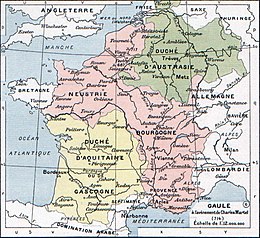Causes and results
The powerful Austrasian mayor of the palace, Pepin II (Pepin or Herstal) had concluded peace with his Neustrian counterpart, Waratton, in 680/681, which included the transfer of hostages to ensure peace. However, Waratton's successors had renewed the conflict between Austrasia and Neustria. Theuderic III—born and raised in Neustria and a Neustrian at heart—and the nobles of Neustria and Burgundy, under their mayor, Berchar, invaded Austrasia territory. Berchar and Theuderic were routed at Tertry by Pepin in 687 and the Austrasians held the field. Historian Michael Frassetto avows that the war during which the battle of Tertry occurred, was essentially the result of a long-standing feud between Austrasian and Neustrian leaders and the civil strife within Neustria itself. According to the text of the Annales mettenses priores—likely written at the Chelles monastery—Pepin II had led the Austrasians to a magnificent victory during the battle of Tertry. Thereby, the Austrasian Pepin extended his family's "control and influence over Neustria".
Their supremacy vindicated on a battlefield, the victors forced Berchar out of office and Pepin appointed Nordebert to act on his behalf in Neustria. The king was forced to recognise Pepin's mayorship over Austrasia, Neustria and Burgundy. Pepin subsequently had his son Drogo betrothed to Anstrudis, the widow of Berchar, who was also the daughter of Waratto so as to secure a kin network. Instead of otherwise alienating the Neustrians, Pepin merged the Neustrian Sippe into his own, becoming "part of the foundation of Arnulfing power."
Eclipsing the Neustrian Mayors, Pepin's victory brought about the effective end of the old seat of Merovingian power, enabling the Arnulfing Mayors to control Neustrian political developments. According to historian Rosamond McKitterick, the Battle of Tertry constitutes one of the decisive moments for the Carolingian house and its history. Despite the importance of Tertry in strengthening Pepin's position, it was another two generations before Pepin the Short claimed the kingship of the Franks.
Legacy
The repercussions of the battle were the reduction of royal authority for Neustria; the supremacy of Austrasia over the rest of the realm, characterised by later conquests to the east and the Aachen-centred Carolingian Empire; the undisputed right to rule of the Arnulfing clan, Pepin even taking the title of dux et princeps Francorum or more recognizable to modern readers as "ruler of all of Francia". Pepin spent the remainder of the seventh century and the early years of the eighth-century reestablishing Frankish supremacy in Germany, during which time he forced the Frisians, Saxons, Alemanni, Suebians, Thuringians, and Bavari peoples to acknowledge their subordination to the Franks.
From the battle of Tertry forward, a mayor from Pepin's clan remained the senior figure within Francia. Under Pepin's heir—his illegitimate son Charles Martel—the Franks would achieve their most important victory in checking the Muslim advance into central Europe. Martel's rule also delineates the beginning of Carolingian power.
This page is based on this
Wikipedia article Text is available under the
CC BY-SA 4.0 license; additional terms may apply.
Images, videos and audio are available under their respective licenses.
